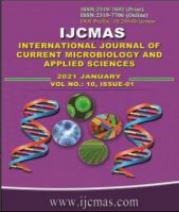


 National Academy of Agricultural Sciences (NAAS)
National Academy of Agricultural Sciences (NAAS)

|
PRINT ISSN : 2319-7692
Online ISSN : 2319-7706 Issues : 12 per year Publisher : Excellent Publishers Email : editorijcmas@gmail.com / submit@ijcmas.com Editor-in-chief: Dr.M.Prakash Index Copernicus ICV 2018: 95.39 NAAS RATING 2020: 5.38 |
In present study, six insect species viz., Aphis gossypii (Glover), Amrascabiguttula biguttula (Ishida), Bemisia tabaci (Gennadius) and Sylepta derogata (Fabricius), Dysdercus cingulatus (Fabricius) and Earias vittella (Fabricius) were recorded as major pests of okra during rabi and kharif seasons, 2017. It was noticed that, Aphid, jassid, white fly and leaf roller remained fromvegetative to harvesting stage while red cotton bug and shoot and fruit borer appeared from reproductive to harvesting stage of the crop. The coccinellids, viz., Coccinella transversalis (Fabricius) and Menochiluss exmaculatus (Fabricius) were present in field with the population of sucking pests. In rabi season, minimum temperature showed positive significant correlation with D. cingulatus and E. vittella (r = 561*, 740*). All weather parameters showed non significant relationship with pests and predators except morning relative humidity which had significant negative impact on D. cingulatus (r = -0.578*) and E. vittella (r = -0.616*) during kharif, 2017.
 |
 |
 |
 |
 |